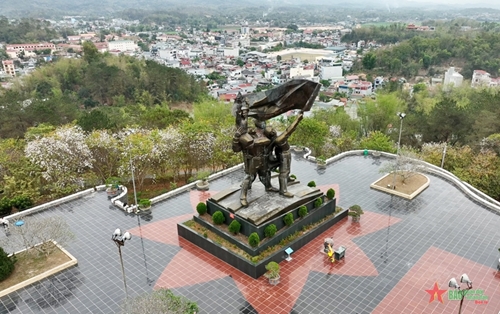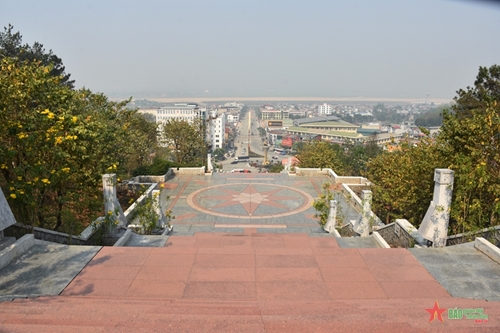Over the past 20 years, the monument complex has been regarded a park of victory and peace and the pride and honor of the provincial people.
    |
 |
|
A aerial view of Dien Bien Phu Victory Monument |
The monument includes a 12.6m statue placed on a 3.6m base. The statue was cast from 217 tons of copper and sketched by sculptor Nguyen Hai from Tien Giang province. Sculptor Hai was a soldier of famous Battalion 307. In 1963, he graduated from the Hanoi University of Fine Arts and started composing the monument. Attentively, the sculptor had not visited Dien Bien. His idea for the monument came from paintings, photos, books, newspapers, songs, including those by musicians Hoang Van, and Huy Du. Hai’s work was completed in late 1964.
According to guide Pham Thi Tinh from the Dien Bien provincial Relic Management Board, the statue features three soldiers standing back to back, one of them flying the “Determined-to-fight, Determined-to-win” flag, and another holding a Thai ethnic child who is raising aloft a bouquet of flowers while the remaining soldier is in state of vigilance and combat readiness.
    |
 |
|
Tourists pose for photo before the monument. |
The bouquet of flowers represents military artists and composers who have been praising the historic Dien Bien Phu Victory which went down in history of the nation. The Thai baby represents the younger generations of ethnic groups to contribute to building the prosperous and beautiful Northwestern locality.
The casting of the monument started on November 14, 2003 by the Central Fine Arts Company under the Ministry of Culture and Information (now the Ministry of Culture, Sports, and Tourism). At that time, the Dien Bien Phu Victory Monument was the highest, biggest and heaviest copper work in Vietnam.
After eight days of travelling by both road and waterway on a distance of nearly 700km from Nam Dinh province, the convoy transporting parts of the monument reached the gateway of Dien Bien Phu city at noon on March 1, 2004 and was warmly welcomed by local students, armed forces and ethnic minority people with flags and flowers. On April 30, 2004, the monument was inaugurated.
    |
 |
|
The yard which hosts artistic and ceremonial events |
    |
 |
|
The largest stone relief in Southeast Asia to the South of the yard recaptures the whole historic Dien Bien Phu Victory. |
In 2009, on the occasion of the 55th anniversary of the Dien Bien Phu Victory, the second stage of the Dien Bien Phu Victory Monument on Hill D1 project was completed. In the second stage, a ceremonial path and a sightseeing route were built.
The ceremonial path starts from a 3,000 sq.m yard having the largest stone relief in Southeast Asia to the South. The relief, 58m in length, 7.5m in height on average, and 400 tons in weight, was assembled from 217 Thanh Hoa blue stone panels. The relief features chapters of the whole historic Dien Bien Phu Campaign. The chapters are about the Party and Uncle Ho making decisions on choosing Dien Bien Phu as a strategic decisive battlefield to combat the French colonialists, the preparation for the campaign, the development of the campaign, and the triumphal ceremony in Muong Phang on May 13, 1954.
    |
 |
|
Tourists climb 320 steps from the yard to the Dien Bien Phu Victory Monument. On both sides of the path are 56 posts made of Thanh Hoa blue stone, symbolizing the 56 days and nights of our troops during the Dien Bien Phu Campaign. |
The path to the monument has 320 steps and three large standings symbolizing three offensive waves of the campaign. On both sides of the path are 56 posts made of Thanh Hoa blue stones, symbolizing the 56 days and nights of our troops during the Dien Bien Phu Campaign. On both sides of the hill along the path are bauhinia flower trees and other trees creating a natural landscape and a friendly environment for the entire relic.
The sightseeing route consists of five walking paths around Hill D1 and five lookout points symbolizing five main divisions engaging in the Dien Bien Phu Campaign.
The Dien Bien Phu Victory Monument complex is now a tourist attraction in Dien Bien and a destination of victory and peace. It is a symbol of the “Determined-to-combat” and “Determined-to-win” spirit and peace and independence.
Translated by Mai Huong